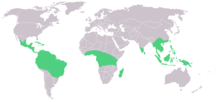Our website is made possible by displaying online advertisements to our visitors.
Please consider supporting us by disabling your ad blocker.
Vanilla (genus)
This article needs additional citations for verification. (May 2009) |
| Vanilla | |
|---|---|

| |
| Flat-leaved vanilla (Vanilla planifolia) | |
| Scientific classification | |
| Kingdom: | Plantae |
| Clade: | Tracheophytes |
| Clade: | Angiosperms |
| Clade: | Monocots |
| Order: | Asparagales |
| Family: | Orchidaceae |
| Subfamily: | Vanilloideae |
| Tribe: | Vanilleae |
| Genus: | Vanilla Plumier ex Mill., 1754 |
| Species | |

| |
| Green: Distribution of Vanilla species | |
| Synonyms[1] | |
| |
Vanilla, the vanilla orchids, forms a flowering plant genus of about 110 species in the orchid family (Orchidaceae). This evergreen genus occurs worldwide in tropical and subtropical regions, from tropical America to tropical Asia, New Guinea and West Africa.[1] Five species are known from the contiguous United States, all limited to southern Florida.[2]
The most widely known member is the flat-leaved vanilla (V. planifolia), native to Mexico and Belize,[3] from which commercial vanilla flavoring is derived. It is the only orchid widely used for industrial purposes in flavoring such products as foods, beverages and cosmetics, and is recognized as the most popular aroma and flavor.[4] The key constituent imparting its flavour is the phenolic aldehyde vanillin.[5]
The genus was established in 1754 by Plumier, after J. Miller. The word vanilla, derived from the diminutive of the Spanish word vaina (vaina itself meaning sheath or pod), simply translates as little pod.
- ^ a b "World Checklist of Selected Plant Families: Royal Botanic Gardens, Kew". kew.org.
- ^ "Vanilla in Flora of North America @ efloras.org". efloras.org.
- ^ Vega, M.; Hernández, M.; Herrera-Cabrera, B.E.; Wegier, A. (2020). "Vanilla planifolia". IUCN Red List of Threatened Species. 2020: e.T103090930A172970359. doi:10.2305/IUCN.UK.2020-2.RLTS.T103090930A172970359.en. Retrieved 19 November 2021.
- ^ Sinha, A. K.; Sharma, U. K.; Sharma, N (2008). "A comprehensive review on vanilla flavor: Extraction, isolation and quantification of vanillin and others constituents". International Journal of Food Sciences and Nutrition. 59 (4): 299–326. doi:10.1080/09687630701539350. PMID 17886091. S2CID 37559260.
- ^ Takahashi M, Inai Y, Miyazawa N, Kurobayashi Y, Fujita A (2013). "Identification of the key odorants in Tahitian cured vanilla beans (Vanilla tahitensis) by GC-MS and an aroma extract dilution analysis". Biosci Biotechnol Biochem. 77 (3): 601–5. doi:10.1271/bbb.120840. PMID 23470766. S2CID 39521387.
Previous Page Next Page


